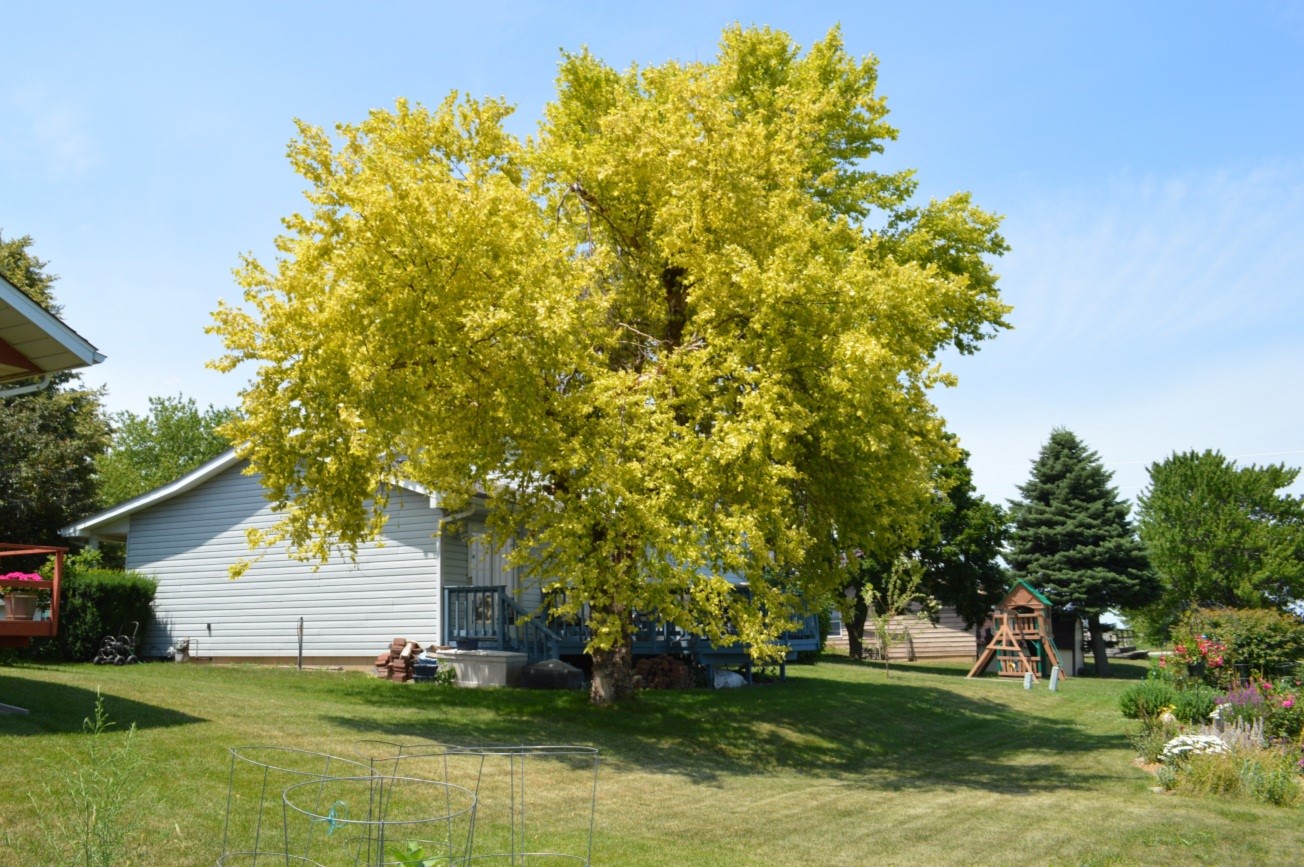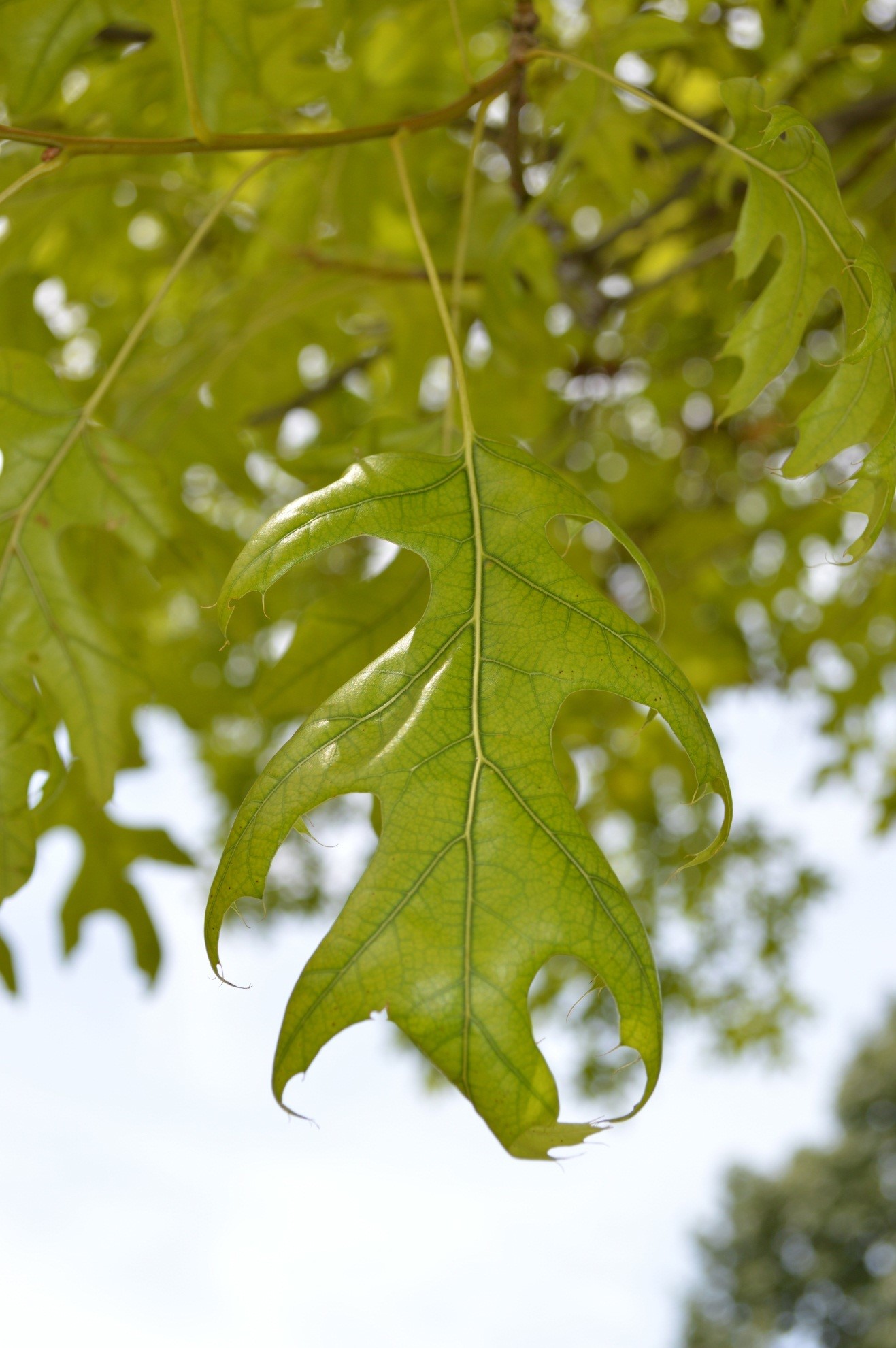Issue 6, July 1, 2021
Iron Chlorosis and Manganese Chlorosis of Shade Trees
Are the leaves on your tree a little more yellow than you remember them being in previous years? You are not alone. I’ve received numerous reports of chlorotic trees from around the state. Chlorosis is a condition in which leaves turn yellow due to the destruction of chlorophyll or lack of chlorophyll production. In most cases, chlorosis results from a nutrient deficiency, either a lack of nutrients or the inability of the plant to uptake the nutrients. Iron (Fe) and manganese (Mn) deficiencies are two of the most common nutrient deficiencies seen in woody landscape plants. Pin oaks are especially prone, though we often see chlorosis affecting sweetgum, maple (especially red, silver and hybrid), and birch.

Severe Iron Chlorosis on River Birch
Iron and manganese chlorosis produce similar symptoms. From a distance, affected trees appear a light green to bright yellow. Up-close inspection reveals yellow-green leaves with dark green veins. Generally, an iron deficiency causes the most intense symptoms on the newest leaves, while manganese deficiencies affect the older leaves. As the chlorosis severity intensifies, leaves develop a brown speckling and larger necrotic (dead) areas. If uncorrected, the tree may progressively decline and dieback over several years and eventually die.

Iron Chlorosis Pin Oak. Note the green leaf veins.

Maple with manganese chlorosis
What causes chlorosis?
In Illinois, high soil pH is the primary cause of iron and manganese chlorosis. In most cases, the soil contains plenty of macro- and micronutrients for tree growth. However, as soil pH rises above 6.5, the iron and manganese present in the soil increasingly convert to forms unavailable to plant roots. While each plant species has its preferred range of soil pH, most of our woody trees like a pH a little below neutral, often in the 6.3 to 6.7 range.
Poor growing conditions can also influence and exacerbate nutrient deficiency and chlorosis. Affected trees are commonly found growing in close proximity to sidewalks, driveways, gravel parking lots, and foundations constructed with limestone bases that raise soil pH. Compacted soils, poor drainage, root injury, drought and flooding all create an environment unfavorable for root growth and nutrient uptake.
Options for Treating Chlorosis
Management for chlorosis involves determining what element is limiting, then trying to alleviate the cause of the deficiency. A soil test can be helpful, both to identify if any major macro- and micronutrients that may be missing, and to check the pH. Several control options are available. Each method has its pros and cons.
- The best long-term solution is to avoid planting tree species susceptible to iron and manganese deficiencies on sites with elevated soil pH. A soil test can verify whether or not the pH is correct and if adequate nutrients are present. This, however, won’t help an existing chlorotic tree.
- Adjust cultural practices to promote steady root growth. Correct poor soil drainage and compaction. Avoid saturating soils with excessive irrigation.
- Fertilize with an available form of iron or manganese, using one several techniques.
- Foliar fertilization is best used for small trees and shrubs. This method involves spraying the micronutrients directly onto the foliage. It offers quick but temporary results, and will need to be reapplied on an annual basis.
- Chelated iron fertilizers can be worked into the soil surrounding the tree using a variety of techniques. The fertilizer can be incorporated into the top few inches of soil, applied to evenly spaced, 12-15” deep holes, or the chelated iron can be dissolved in water and the injected under pressure into the soil.
- A variety of trunk injection technologies are available to treat deficiencies. All require small holes at the base the tree. Results may not be observed until the following growing season. Treatments generally last 2 or more years. While effective, some fear repeated applications may injure the tree.
- Acidifying high pH soils addresses the true cause of the problem. Soil acidification is a challenging task that offers temporary results. Additionally, acidification may not be feasible for larger, established trees. Soils can be acidified using elemental sulfur or iron sulfate. Elemental sulfur is economical, but takes several months to lower the pH. Iron sulfate is more expensive, but will lower the pH in a few weeks.
Author:
Travis Cleveland